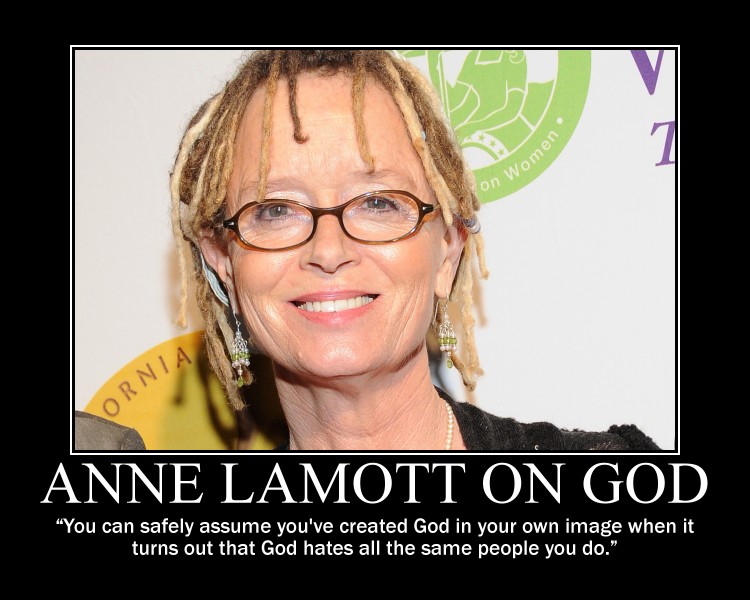
Annie Lamott popularized this saying by her friend Tom Weston, a Jesuit priest.
Weston's insight is so revelatory -- so directly to The Point -- that I repeat it whenever opportunity presents
.
.
"You can safely assume you’ve created God in your own image
when it turns out God hates all the same people you do."
Tom Weston S. J.
Tom Weston S. J.
Weston's line couples well with a telling verse from John's first epistle:
"There is no fear in love. But perfect love drives out fear, because fear has to do with punishment.
The one who fears is not made perfect in love."
1 John 4:18
Anne Lamott on How We Endure and Find Meaning in a Crazy World
by Maria Popova
“The world is always going to be dangerous, and people get badly banged up, but how can there be more meaning than helping one another stand up in a wind and stay warm?”
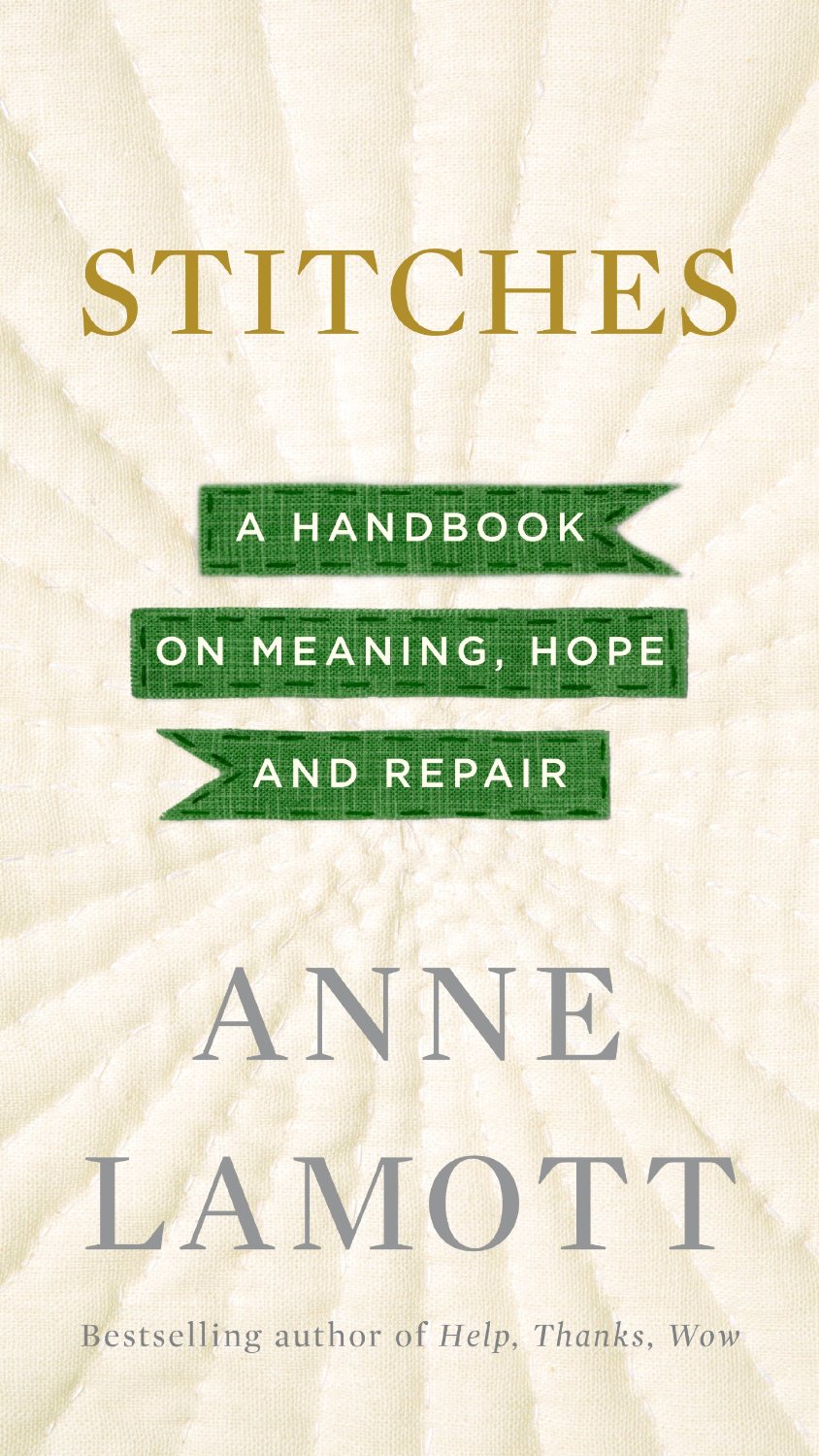 We live in a culture of dividedness and fragmentation of the self. When we contemplate what it takes to live a full life, we extol mindfulness and wholeheartedness. But being wholehearted is only sufficient if your heart is your whole self; being mindful is only sufficient if your mind is all you are. We are, of course, so much more expansive than our hearts and our minds and our perfect abs, or whatever fragment we choose to fixate on. But we compartmentalize our experience in this way, divide it into fragments, as if to divide and conquer it. I’ve written before about our resistance to speaking of the soul, of which those of us who uphold secular ideals of rationalism are especially culpable. And yet I find, over and over, that the fullest people — the people most whole and most alive — are those unafraid and unashamed of the soul.
We live in a culture of dividedness and fragmentation of the self. When we contemplate what it takes to live a full life, we extol mindfulness and wholeheartedness. But being wholehearted is only sufficient if your heart is your whole self; being mindful is only sufficient if your mind is all you are. We are, of course, so much more expansive than our hearts and our minds and our perfect abs, or whatever fragment we choose to fixate on. But we compartmentalize our experience in this way, divide it into fragments, as if to divide and conquer it. I’ve written before about our resistance to speaking of the soul, of which those of us who uphold secular ideals of rationalism are especially culpable. And yet I find, over and over, that the fullest people — the people most whole and most alive — are those unafraid and unashamed of the soul.
The soul has had no greater champion in this age of fragments than Anne Lamott — a writer of exceptional lucidity and enchantment, with a rare way of becalming our modern anxieties and ancient anguishes, from grief and gratitude to the perils of perfectionism to how we keep ourselves small with people-pleasing. In Stitches: A Handbook on Meaning, Hope and Repair (public library), Lamott lays bare the deepest, most worn yet most resilient threads of the soul and laces out of the loose ends an extraordinary lattice of assurance and grace — assurance that there is hope for awakening in ourselves “a deeper sense of immediacy or spirit or playfulness” amid the slumber of ordinary life, and for those moments when we feel like all such hope is lost, the grace of trusting “that we do endure, and that out of the wreckage something surprising will rise.”
A century and a half after Tolstoy tussled with the search for meaning in a seemingly meaningless world, Lamott writes in the opening essay, titled “Beginning”:
We so often lose our way.It is easy to sense and embrace meaning when life is on track. When there is a feeling of fullness — having love, goodness, family, work, maybe God* as parts of life — it’s easier to navigate around the sadness that you inevitably stumble across. Life holds beauty, magic and anguish. Sometimes sorrow is unavoidable, even when your kids are little, when the marvels of your children, and your parental amazement, are all the meaning you need to sustain you, or when you have landed the job and salary for which you’ve always longed, or the mate. And then the phone rings, the mail comes, or you turn on the TV…What is the point of it all when we experience the vortex of interminable depression or, conversely, when we recognize that time is tearing past us like giddy greyhounds? It’s frightening and disorienting that time skates by so fast, and while it’s not as bad as being embedded in the quicksand of loss, we’re filled with dread each time we notice life hotfoot it out of town.One rarely knows where to begin the search for meaning, though by necessity, we can only start where we are… It somehow has to do with sticking together as we try to make sense of chaos, and that seems a way to begin.
In a living testament to Faulkner’s assertion that the writer’s duty is “to help man endure by lifting his heart” and to E.B. White’s conviction that the writer“should tend to lift people up, not lower them down,” Lamott captures the precarious goodwill of the human spirit:
We try to help where we can, and try to survive our own trials and stresses, illnesses and elections. We work really hard at not being driven crazy by noise and speed and extremely annoying people, whose names we are too polite to mention. We try not to be tripped up by major global sadness, difficulties in our families or the death of old pets…We work hard, we enjoy life as we can, we endure. We try to help ourselves and one another. We try to be more present and less petty. Some days go better than others. We look for solace in nature and art and maybe, if we are lucky, the quiet satisfaction of our homes…We’re social, tribal, musical animals, walking percussion instruments. Most of us do the best we can. We show up. We strive for gratitude, and try not to be such babies.And then there’s a mass shooting, a nuclear plant melts down, just as a niece is born, or as you find love. The world is coming to an end. I hate that. In environmental ways, it’s true, and in existential ways, it has been since the day each of us was born.[…]Where is meaning in the meteoric passage of time, the speed in which our lives are spent? Where is meaning in the pits? In the suffering? I think these questions are worth asking.
But in asking these questions, Lamott observes — as Meghan Daum did in hereloquent defiance of the platitude industrial complex — that we rarely afford adversity anything more than the status of a complacent metaphor:
Our lives and humanity are untidy: disorganized and careworn. Life on earth is often a raunchy and violent experience. It can be agony just to get through the day.And yet, I do believe there is ultimately meaning in the chaos, and also in the doldrums. What I resist is not the truth but when people put a pretty bow on scary things instead of saying, “This is a nightmare. I hate everything. I’m going to go hide in the garage.”[…]My understanding of incarnation is that we are not served by getting away from the grubbiness of suffering. Sometimes we feel that we are barely pulling ourselves forward through a tight tunnel on badly scraped-up elbows. But we do come out the other side, exhausted and changed.[…]To heal, it seems we have to stand in the middle of the horror, at the foot of the cross, and wait out another’s suffering where that person can see us.
Photograph by Mark Nixon from 'Much Loved,' a collection of people's childhood teddy bears loved down to bare threads. Click image for more.
Echoing Emerson’s notion that life is a series of surprises, which we mostly resist, Lamott considers the inevitable ebb and flow of the human experience — the same cycling of impoverishment and excess that Rilke memorably extolled— and writes:
No matter what happens to us — to our children, to our town, to our world — we feel it is still a gift to be human and to have a human life, as long as we ignore the commercials and advertisements and the static that the world beams at us, and understand that we and our children are going to get knocked around, sometimes so cruelly that it will take our breath away. Life can be wild, hard and sweet, but it can also be wild, hard and cruel.The bad news is that after the suffering, we wait at the empty tomb for a while, the body of our beloved gone, grieving an unsurvivable loss.It’s a terrible system. But the good news is that then there is new life. Wildflowers bloom again… They’re both such surprises. Wildflowers stop you in your hiking tracks. You want to savor the colors and scents, let them breathe you in, let yourself be amazed. And bulbs that grow in the cold rocky dirt remind us that no one is lost.
But nowhere are these surprises at their most acute, or their most unwelcome, than in loss. “Grief, when it comes,” Joan Didion wrote in her indispensable memoir of loss, “is nothing like we expect it to be” — a notion Lamott enlivens with her touch of poetic precision:
Most of us have figured out that we have to do what’s in front of us and keep doing it… Every time we choose the good action or response, the decent, the valuable, it builds, incrementally, to renewal, resurrection, the place of newness, freedom, justice…We live stitch by stitch, when we’re lucky. If you fixate on the big picture, the whole shebang, the overview, you miss the stitching. And maybe the stitching is crude, or it is unraveling, but if it were precise, we’d pretend that life was just fine and running like a Swiss watch. This is not helpful if on the inside our understanding is that life is more often a cuckoo clock with rusty gears.In the aftermath of loss, we do what we’ve always done, although we are changed, maybe more afraid. We do what we can, as well as we can.[…]A great truth, attributed to Emily Dickinson, is that “hope inspires the good to reveal itself.” This is almost all I ever need to remember. Gravity and sadness yank us down, and hope gives us a nudge to help one another get back up or to sit with the fallen on the ground, in the abyss, in solidarity.
That solidarity, Lamott argues in a sentiment that calls to mind Jeanette Winterson’s exquisite notion of “the paradox of active surrender,” is often what art gives us:
When you love something like reading — or drawing or music or nature — it surrounds you with a sense of connection to something great. If you are lucky enough to know this, then your search for meaning involves whatever that Something is. It’s an alchemical blend of affinity and focus that takes us to a place within that feels as close as we ever get to “home.” It’s like pulling into our own train station after a long trip — joy, relief, a pleasant exhaustion.If a writer or artist creates from a place of truth and spirit and generosity, then I may be able to enter and ride this person’s train back to my own station. It’s the same with beautiful music and art.Beauty is meaning.
But rather than a compendium of philosophical reflections suspended mid-air by the free-hanging laziness of aphorism, Lamott’s book is a tapestry of real stories — “real” in the rawest, most soul-shaking sense of the word — from which her firmly grounded yet elevating wisdom springs. In another essay, Lamott — a staunch champion of the uncomfortable art of letting yourself be seen — recounts her own journey from a difficult childhood to self-destruction to recovery and meaning. In a passage that evokes Henry Miller’s assertion that“it takes only one friend, if he is a man of faith, to work miracles,” she writes:
What saved me was that I found gentle, loyal and hilarious companions, which is at the heart of meaning: maybe we don’t find a lot of answers to life’s tougher questions, but if we find a few true friends, that’s even better. They help you see who you truly are, which is not always the loveliest possible version of yourself, but then comes the greatest miracle of all — they still love you.[…]I also learned that you didn’t come onto this earth as a perfectionist or control freak. You weren’t born a person of cringe and contraction. You were born as energy, as life, made of the same stuff as stars, blossoms, breezes. You learned contraction to survive, but that was then. You have paid through the nose — paid but good. It is now your turn to reap.[…]It can be healthy to hate what life has given you, and to insist on being a big mess for a while. This takes great courage. But then, at some point, the better of two choices is to get back up on your feet and live again.
In the fourth essay, Lamott revisits this subject of how we embolden each other to go on living. Echoing Emerson’s unforgettable contention that “people wish to be settled [but] only as far as they are unsettled is there any hope for them,”she writes:
Alone, we are doomed, but by the same token, we’ve learned that people are impossible, even the ones we love most —especially the ones we love most: they’re damaged, prickly and set in their ways. Also, they’ve gotten old and a little funny, which can be draining. It is most comfortable to be invisible, to observe life from a distance, at one with our own intoxicating superior thoughts. But comfort and isolation are not where the surprises are. They are not where hope is… Only together do we somehow keep coming through unsurvivable loss, the stress of never knowing how things will shake down, to the biggest miracle of all, that against all odds, we come through the end of the world, again and again — changed but intact (more or less)… Insofar as I have any idea of “the truth,” I believe this to be as true as gravity and grace.[…]I’ve always loved funky rustic quilts more than elegant and maybe lovelier ones. You see the beauty of homeliness and rough patches in how they defy expectations of order and comfort. They have at the same time enormous solemnity and exuberance. They may be made of rags, torn clothes that don’t at all go together, but they somehow can be muscular and pretty. The colors are often strong, with a lot of rhythm and discipline and a crazy sense of order. They’re improvised, like jazz, where one thing leads to another, without any idea of exactly where the route will lead, except that it will refer to something else maybe already established, or about to be. Embedded in quilts and jazz are clues to escape and strength, sanctuary and warmth. The world is always going to be dangerous, and people get badly banged up, but how can there be more meaning than helping one another stand up in a wind and stay warm?
Stitches is a soul-stretching read in its totality — the kind you revisit again and again, and find especially assuaging assurance in during life’s darkest moments. Complement it with Lamott on the greatest gift of friendship, Meghan Daum onhow we become who we are, and Victoria Safford on what hope really means.
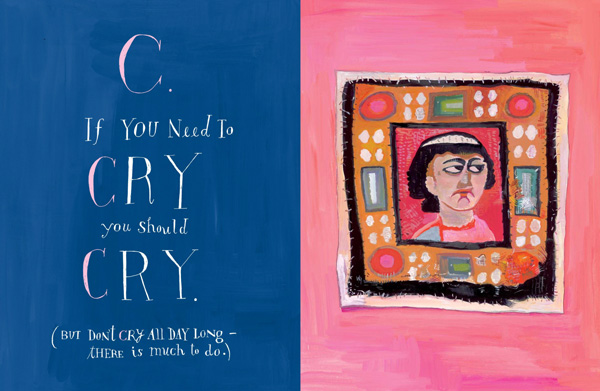
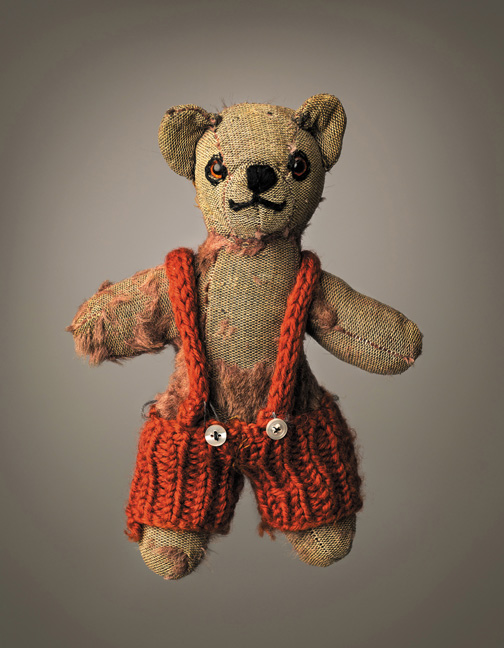
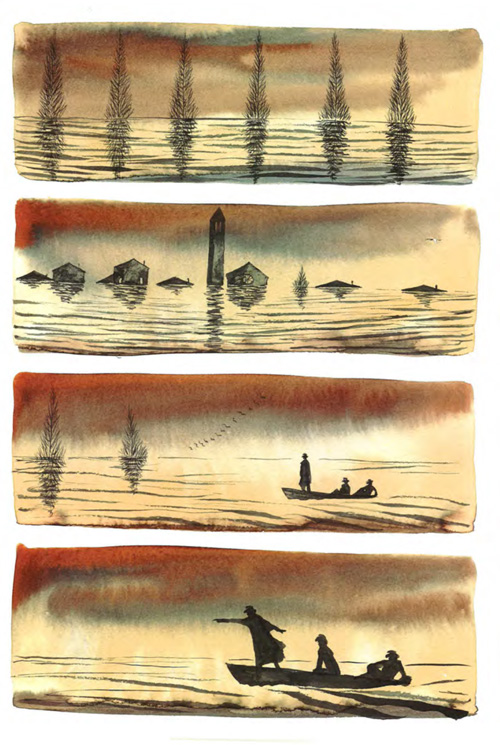
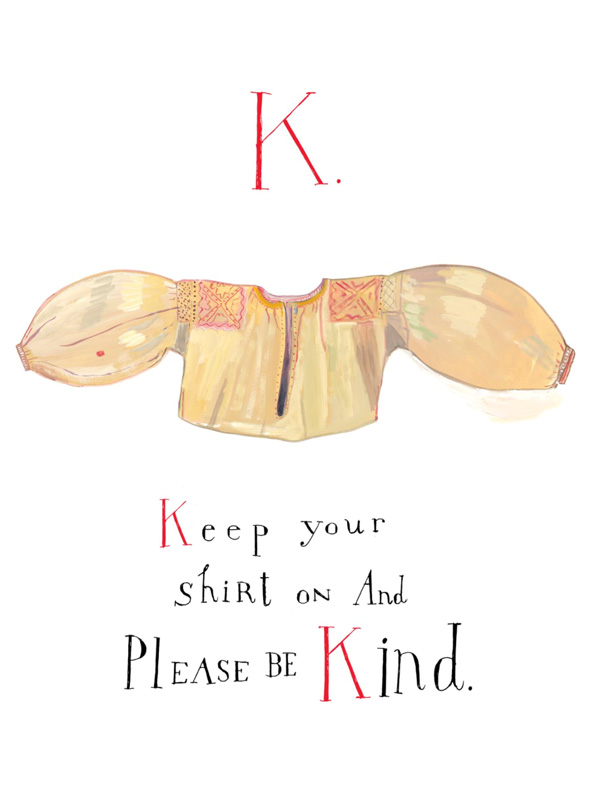
No comments:
Post a Comment